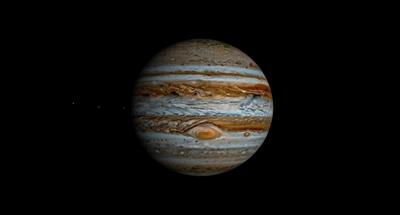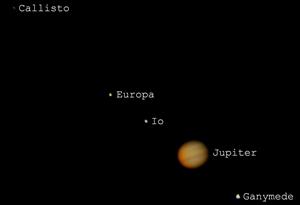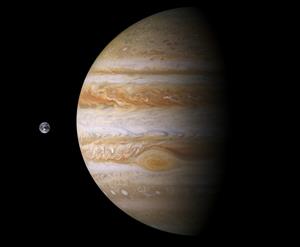
PUMPA - SMART LEARNING
எங்கள் ஆசிரியர்களுடன் 1-ஆன்-1 ஆலோசனை நேரத்தைப் பெறுங்கள். டாப்பர் ஆவதற்கு நாங்கள் பயிற்சி அளிப்போம்
Book Free DemoJupiter is the fifth planet in the solar system and the first gaseous giant after the asteroid belt. This Jovian planet was discovered by Galileo Galilei in \(1610\) using his small telescope. 'Jovian' is a word derived from 'Jove', a name for the Roman god 'Jupiter', meaning 'Jupiter-like'.

Jupiter
Jupiter has three faint rings around it, which is hardly visible from Earth. This planet appears brownish-yellow. The period of rotation is \(9.92\ hours\), and the period of revolution is \(12\ years\).
Satellites of Jupiter:
Jupiter has a large number of moons or satellites around it. Till date, it has \(65\) moons with a stable orbit, out of which four of its large moons can be seen using a telescope.
Jupiter has a large number of moons or satellites around it. Till date, it has \(65\) moons with a stable orbit, out of which four of its large moons can be seen using a telescope.

Natural satellites of Jupiter
Galileo Galilei also discovered four moons (Io, Ganymede, Callisto and Europa) of Jupiter. Ganymede is the largest moon or natural satellite in the solar system.
Comparison with Earth:
Jupiter is the largest planet, which rotates rapidly on its axis. Even though it is a giant, the mass of Jupiter is about \(318\) times that of the Earth. It is a giant planet that can occupy around \(1331\) earth inside. On comparing the radius, Jupiter is \(11\) times that of the Earth.
Jupiter is the largest planet, which rotates rapidly on its axis. Even though it is a giant, the mass of Jupiter is about \(318\) times that of the Earth. It is a giant planet that can occupy around \(1331\) earth inside. On comparing the radius, Jupiter is \(11\) times that of the Earth.

Earth and Jupiter
Important!
The Great Red Spot is a huge massive storm that swirls around in the anticlockwise direction at a wind speed of more than \(400\ km/h\). This gigantic storm is about twice the size of Earth.
Reference:
https://live.staticflickr.com/3833/13906468084_3761d955fe_b.jpg
https://upload.wikimedia.org/wikipedia/commons/f/f7/Jupiter%27s_Galilean_Moons.jpg